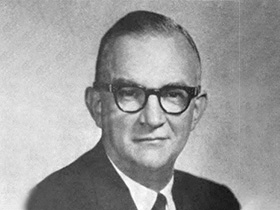You are here

7/23/1908 - 10/28/1973
Republican Congressman John Phillips Saylor was the driving force behind important environmental legislation in the 1960s.
John Phillips Saylor was born in Cambria County to Tillman and Minerva Phillips Saylor in 1908. He remained in his home city of Johnstown for much of his political career, but often fought for environmental legislation which would affect the great west of the United States. Most memorable were his years of service as a Republican congressman for the state. An outdoorsman, conservationist, and environmentalist, Saylor was spoken highly of by acquaintances. His tireless efforts to preserve our nation's wilderness were critical to U.S. environmental history. Saylor died in Texas in 1973 and is buried in his beloved home state of Pennsylvania.
John Phillips Saylor, also known as John P. Saylor or "St. John" by environmental supporters, was born on July 23, 1908, on a small farm five miles outside of the city of Johnstown, Cambria County, Pennsylvania. Of Mennonite heritage, Saylor's forefathers had migrated from Philadelphia to the Johnstown area around the 1850s. Son to Tillman K. and Minerva Phillips Saylor, he was raised in the comfortable middle-class. Tillman was a school teacher who later pursued law. Minerva, also a former school teacher, had retired from the job to raise her children: John, the eldest, Anna Catherine (1911), Margaret (1914), and Tillman Jr. (1917). Saylor was the maternal grandson of John Phillips, and paternal grandson to John Saylor. He was born and raised in the western Pennsylvania coal, iron, and steel country just as both of Saylor's parents had been. Saylor's father and mother pursued degrees at the Indiana Normal School (now Indiana University of Pennsylvania) and the Millersville Normal School (now Millersville University of Pennsylvania).
In his younger years, Saylor was a student at the Adams Street School, followed by the Roxbury School, both public institutions. In 1921, Saylor's sister Margaret died of diphtheria at the age of seven, causing the family to relocate. The Saylors moved often, in part due to Tillman's successful law practice. Additionally, Tillman was heavily involved with the United Church of Christ. Saylor's parents insisted upon religious teachings and a strong faith. They also put stock in a good education and continually impressed this value upon their children. However, Saylor himself was often assumed to be the least intellectual of the children but overcompensated with a likeable personality. Determined, Saylor had listed in the high school yearbook that his goal was "to become a lawyer." At age 16, he would attend Mercersburg Academy, located near the Maryland border, in preparation for college.
Growing up, Saylor was exposed to a bustling downtown Johnstown in the 1920s. Though he appreciated the entertainment of the time, Saylor was more likely to be found out in the countryside enjoying nature. His parents instilled in he and in younger brother Tillman Jr. a passion for outdoor activities. Upon entering adulthood, Saylor had much exposure to the conservationist as well as preservationist viewpoints toward the environment, which would be evidenced strongly years later.
It was during his stay at Mercersburg Academy that Saylor was recognized not as an underachieving student, but rather as a competent public speaker in his senior English course. Saylor stood six feet four inches tall, and although thin, had all the earmarks of an active, outgoing athlete. On the contrary, he never thrived on athletic competitions, nor did he take much pleasure in joining school organizations with classmates. Still troubled by his grades, Saylor was nearing academic probation and the academy went so far as to discuss the problem with Tillman. Saylor completed schooling at the academy in 1925 after being accepted by his prospective college, Franklin and Marshall.
A graduate of Franklin and Marshall College in Lancaster, and later the Dickinson College School of Law, Saylor made no attempt to hide the fact that academics were not his strong point. He majored in English, but got the higher marks in history courses. He joined the Chi Phi fraternity and even played varsity football for one unsuccessful season. Somewhat of a social butterfly, Saylor once claimed that Franklin and Marshall College cramped his style.
In 1929, after receiving a degree from Franklin and Marshall, Saylor made a failed attempt to enroll in the fall semester at Tillman's alma mater, the University of Michigan Law School. Due to his low grades, the university asked Saylor to leave and he promptly enrolled at the Dickinson College School of Law, in Carlisle, Pennsylvania in the fall of 1930. His intentions were good, but his timing was bad as he struggled through classes during the height of the depression.
Directly after graduation from law school and passing the bar, Saylor had a secure job at his father's law firm in their hometown of Johnstown. The nation was suffering, but Tillman's practice maintained a steady business throughout. Working at his father's office, Saylor had more than just political and environmental issues on the brain; he was in pursuit of Grace Doerstler, the daughter of a Pennsylvania Railroad brakeman. In 1937, the two got married in the chapel of the Union Theological Seminary near Saylor's alma mater, Franklin and Marshall. Buying a house in Johnstown, the new family proceeded to live there for about 13 years.
Tragically, during the following year, Saylor's father died of a heart attack at age 50. Under grim circumstances, this chain of events led Saylor to succeed his father as the new city solicitor of Johnstown. It was a beacon of hope among troubled times when Saylor and wife Grace gave birth to their first child, John Phillips Jr. in 1941. Saylor would hold the title of city solicitor of Johnstown until 1942. Shortly thereafter, Saylor volunteered for service with the U.S. Navy in World War II, and rose to position of lieutenant (junior grade).
Saylor left the Navy (but joined the Naval Reserve) on Thanksgiving Day, 1945, and returned to his family, including his second child, newly born Susan Kathleen (1946). Picking up where he left off with his law career, Saylor never seemed completely content. He soon sought the Republican nomination as the congressional seat for his district when it became available by special election upon the passing of Robert L. Coffey.
Saylor's father was often quoted as saying that the federal lands belonged to the American people and it was the duty of our Congress to protect the public estate from being ruined. Living in Johnstown was perhaps more incentive for Saylor and his late father to appreciate natural beauty. The city was becoming more polluted and served to rationalize the choice of the Saylor family to join a Sportsmen's Association. Located in Potter County, Lost Cabin drew Saylor to its solitude, hunting, fishing, and hiking.
From his position as Johnstown city solicitor, Saylor had earned respect while also making a name for himself. On September 13, 1949, by way of a special election, John Phillips Saylor was elected as the Republican candidate to represent the Pennsylvania 26th Congressional District in the U.S. House of Representatives. The district included Armstrong, Cambria, and Indiana counties. People said that Saylor campaigned easily, going door-to-door, exchanging pleasantries with the citizen voters of the district. He won the position by over 8,500 votes. In the book titled Green Republican, Thomas G. Smith notes that Saylor was advantageous in that "he was an attractive, amiable, hardworking male candidate with a respectable war record, running in a district that was predominantly Republican." He was sworn into office of the first session, 81st Congress on September 28, 1949.
Saylor was a member of the second session of the Eighty-first Congress which began January 3, 1950, and continued for one year thereafter. In his first years in politics, Saylor's focus was on regulatory committee work and protecting Pennsylvania's pertinent economic issues. Colleagues claimed that Saylor enjoyed his work and was doing an excellent job. In 1951, he showed interest in the House Interior Committee and became involved with Western water issues of the U.S. It was evident early on that Saylor, though heavily involved with his district in Pennsylvania, was growing increasingly concerned with preservation issues in the rest of America.
Saylor was a Republican congressman in office who represented the western Pennsylvania coal-mining district from 1949 to 1973. Friends agreed that Saylor had a good sense of humor. His political slogan, a pun on his last name, was "Keep Sailing with Saylor" and throughout his political career, rarely did he put economic development ahead of environmental issues.
The United States Bureau of Reclamation became familiar with the likes of John Philips Saylor as he continually fought their "appetite" for dam building. Projects such as the Bridge Canyon Dam on the lower Colorado River, the Colorado River Storage Project (CRSP), Echo Dam, Flaming Gorge, Glen Canyon Dam, Grand Coulee Dam, and the Hells Canyon project were among many over which Saylor found himself embroiled in debate.
Saylor was best known for his adamant stands in regards to many notable pieces of environmental legislation. Perhaps his greatest success was the passing of the Wilderness Act of 1964. He fought tirelessly for eight years amending and reworking the bill until it was favorable enough to pass in Congress. The bill protected over nine million acres of wilderness in America's west. He also was involved in the Ozark National Scenic Riverways Act as well as the National Wild and Scenic Rivers Act of 1968. Both acts sought to protect free-flowing rivers from damming projects which were typically spear-headed by the Bureau of Reclamation. ?ö During his political years and beyond, Saylor was liked by many, hated by some, but respected by all. His strong opinions and quick tongue left many questioning his stringent preservationist viewpoint. Wayne Aspinall (chairman), John Dingell (D-MI, closest congressional colleague to Saylor), Floyd Dominy (director, Bureau of Reclamation), Howard Zahniser (executive director, the Wilderness Society) and Morris Udall (Arizona) were persons of political importance with whom Saylor conversed, and often argued with, for years.
President Gerald Ford referred to Saylor as the congressional Theodore Roosevelt, who was Saylor's role model. Saylor protected countless acres of wilderness and scenic areas in the United States. While in Houston, Texas for heart surgery, on October 28, 1973, John Phillips Saylor died. He is buried in the Grandview Cemetery, in Johnstown, Pennsylvania, near his birthplace. Saylor was succeeded in office by John Murtha. The John P. Saylor Trail in Gallitzin State Forest is named after "St. John" and stands as a constant reminder of his efforts to preserve America's rivers and wilderness.
- Ozark National Scenic Riverways Act (August 24, 1964)
- National Wild and Scenic Rivers Act (October 2, 1968)
- Wilderness Act of 1964 (September 3, 1964)
- "Rep. John Saylor of Pennsylvania." New York Times 29 Oct. 1973: 38.
- "Saylor, John Phillips." Biographical Directory of the United States Congress, 1771- Present. 22 July 2007. <http://www.infoplease.com/biography/us/congress/ saylor-john-phillips.html>.
- Smith, Thomas G. Green Republican. Pittsburgh, PA: U of Pittsburgh P, 2006.
- Smith, Thomas G. "Saylor, John Phillips." American National Biography. Aug. 2003. 22 July 2007. <>http://www.anb.org/articles/07/07-00785.html>.
- Smith, Thomas G. "Voice for Wild and Scenic Rivers: John P. Saylor of Pennsylvania". Pennsylvania History 66:4 (1999): 554-579.
- Wood, Karen. "John P. Saylor: Conservationist in Congress." IUP Libraries, Special Collections and Archives. 15 July 2001. 22 July 2007. <>http://www.lib.iup.edu/depts/speccol/exhibits/saylor.html>.
Photo Credit: "John P. Saylor." 1965. Photography. Licensed under Public Domain. Cropped to 4x3, filled background. Source: Eighty-Ninth Congress, Pocket Congressional Directory. Source: Wikimedia.
